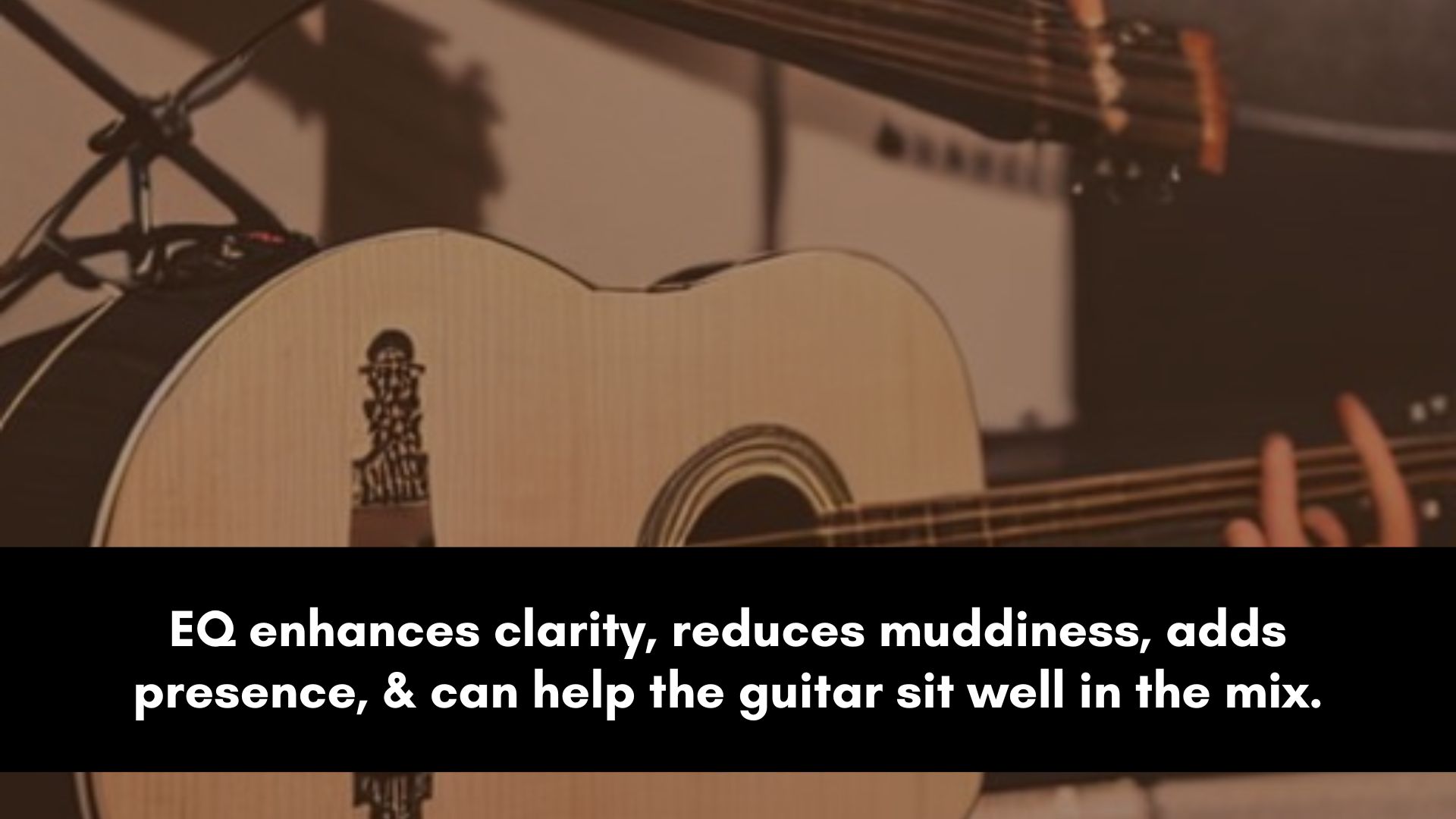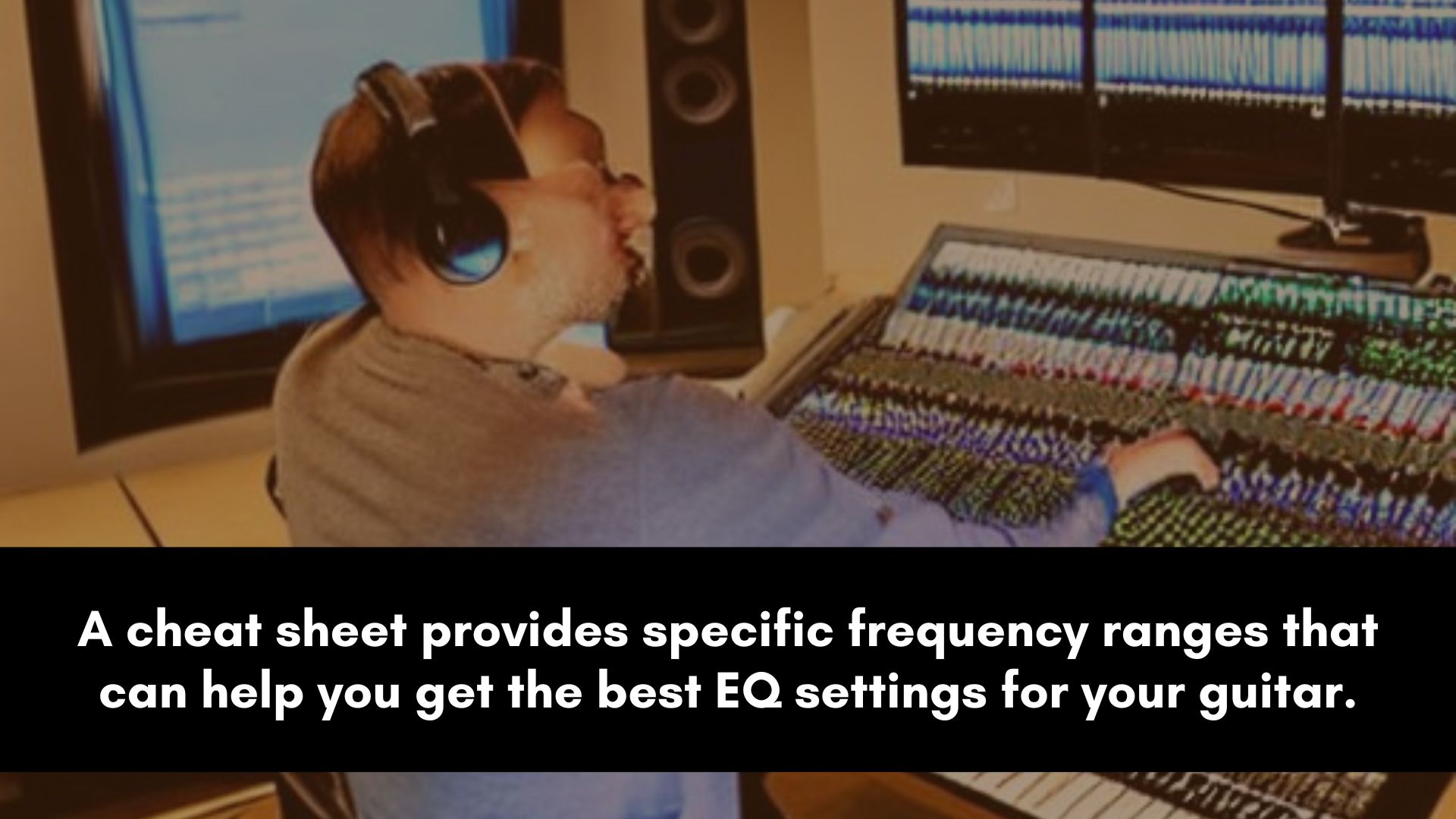In the vast realm of music production, there is a mystique surrounding the art of EQing acoustic guitars.
It's a delicate dance between science and creativity, where frequencies intertwine to shape the soulful strums and gentle melodies.
Join us on an auditory adventure as we unravel the secrets behind achieving pristine tonal balance and unlocking the true potential of your acoustic guitar.
How to EQ an Acoustic Guitar Like a Pro

EQ is one of the secret sauces that can elevate your acoustic guitar sound from bland to brilliant.
Proper EQing can enhance clarity, warmth, and balance, creating a rich and immersive listening experience.
Without EQ, your guitar sound may lack depth, presence, and definition, resulting in a dull and uninspiring performance.
Don't let your sound fall flat; unleash the power of EQ.
Understanding Acoustic Guitar Frequencies
Before we can learn how to EQ an acoustic guitar, we need to understand the different frequencies that the guitar produces.
Understanding the distinctive characteristics of low, mid, and high frequencies will enable us to sculpt the perfect tone with surgical precision.
1. Low frequencies: The Foundation of Resonance
Low frequencies, typically ranging from 20 Hz to around 250 Hz, form the foundation of your acoustic guitar's resonance and warmth.
They provide the deep, rich tones that give your guitar its body and thickness.
However, excessive low frequencies can result in a muddy or boomy sound.
If you find your acoustic guitar's sound lacking clarity and definition, try reducing frequencies below 100 Hz to eliminate unwanted rumble and boominess while preserving the instrument's warmth.
2. Mid frequencies: The Essence of Clarity and Presence
Midrange frequencies, occupying the range of around 250 Hz to 4 kHz, are the heart and soul of your acoustic guitar's clarity and presence.
They encompass the fundamental tones and harmonics, providing articulation and defining the character of your sound.
For instance, to enhance the acoustic guitar's tonal presence and ensure it cuts through the mix, boost frequencies around 1 kHz.
This will add clarity and brilliance to your sound, making it stand out without overpowering other instruments.
Manipulating midrange frequencies can make your guitar shine or tame any harshness.
3. High frequencies: Sparkle and Brilliance
High frequencies, residing in the range of 4 kHz to 12 kHz, contribute sparkle, brilliance, and articulation to your acoustic guitar's sound.
They add shimmering harmonics and subtle details that enhance the overall tonal definition.
If you find yourself mixing an acoustic guitar that lacks brightness and articulation, try gently boosting frequencies around 8 kHz.
This will infuse your sound with a pleasant sparkle, allowing delicate nuances and intricate fingerpicking to shine through.
However, excessively high frequencies can lead to a harsh or piercing sound.
Understanding the unique characteristics of these frequency ranges is essential for precise EQing.
By intelligently manipulating low, mid, and high frequencies, you can sculpt a well-balanced and captivating acoustic guitar tone that captivates listeners.
Best EQ Settings for Acoustic Guitar

When it comes to achieving optimal EQ settings for your acoustic guitar, a precise approach is key.
By separating surgical EQ techniques (cutting frequencies) from tonal EQ adjustments (boosting frequencies), you can sculpt the perfect tone with very little guesswork.
Let's dive into the EQ settings for each specific frequency range:
Surgical EQ Techniques:
- Rumble (20 Hz - 80 Hz): To eliminate unwanted low-frequency rumble and improve clarity, apply a high-pass filter or gently reduce frequencies below 80 Hz.
- Boominess (100 Hz - 250 Hz): Reduce excessive boominess (from the sound hole) by applying a cut in the range of 100 Hz–250 Hz. This helps to tame muddiness and create a tighter, more focused tone.
- Noise and Brittle (+12 kHz): Use a low pass filter to cut out anything above 12 kHz because there’s nothing but unwanted high-pitched ringing.
Tonal EQ Adjustments:
- Body (200 Hz - 300 Hz): Enhance the body and richness of your acoustic guitar by applying a slight boost in the range of 200 Hz–300 Hz. This adds depth and warmth to the sound without overwhelming other frequency ranges.
- Strings (700 Hz and Up): To bring out the clarity and definition of the guitar strings, apply a gentle boost in the higher frequency range, starting from around 700 Hz. This helps to highlight the intricacies of your playing.
- Presence (2 kHz - 5 kHz): To enhance the presence and projection of your acoustic guitar, boost frequencies in the range of 2 kHz–5 kHz. This adds clarity and articulation to your playing, allowing it to cut through the mix.
- Brightness (5 kHz - 8 kHz): For a touch of sparkle and brilliance, apply a subtle boost in the range of 5 kHz–8 kHz. This adds shimmering harmonics and brings out the high-end detail of your acoustic guitar.
EQ Techniques for Different Acoustic Guitar Styles

Acoustic guitars come in various styles, each with its own unique sonic requirements.
To achieve the desired sound for different playing styles, it's important to apply specific EQ techniques.
Let's explore how to tailor your EQ settings for fingerstyle guitar, strumming and rhythm guitar, and acoustic guitar solos.
Get ready to unlock the true potential of your instrument across different musical genres.
a. Fingerstyle guitar
Fingerstyle guitar playing emphasizes intricate picking patterns and delicate finger movements.
To enhance the nuances of fingerstyle playing, try these EQ techniques:
- Boost the high frequencies: Increase frequencies around 6 kHz to bring out the clarity and articulation of individual notes.
- Slightly reduce low-mid frequencies: Softly attenuate frequencies around 200 Hz to reduce muddiness and create a cleaner, more defined sound.
That will often accentuate the crispness of your fingerpicking while subtly reducing the low-mid frequencies to avoid muddiness in complex passages.
b. Strumming and rhythm guitar
For strumming and rhythm guitar, EQ techniques focus on achieving a balanced and full-bodied sound that cuts through the mix.
Consider the following techniques:
- Enhance the midrange frequencies: Boosting the midrange frequencies around 1 kHz can add presence and ensure your strumming cuts through without overpowering the other sounds in the mix.
- Moderate boost in low frequencies: Apply a gentle boost around 80 Hz to 120 Hz to add warmth and depth to your strumming.
This usually brings out the punch and clarity while adding a subtle boost in low frequencies for a fuller and more vibrant sound.
c. EQing an acoustic guitar solo
For captivating solos that command attention, specific EQ techniques can help your acoustic guitar soar above the mix.
You can try the following approaches:
- Thin lower midrange: in cases where your guitar is sounding too thin, you may want to boost the frequencies around 200 Hz–300 Hz to add some body.
- Pronounced midrange boost: Enhance frequencies around 1 kHz to 2 kHz to ensure your solo stands out with clarity and projection.
- Controlled high-end frequencies: Tame excessive high frequencies around 4 kHz to 8 kHz to prevent harshness while maintaining articulation.
When mixing acoustic guitar solos, try a pronounced midrange boost to make your melodic lines shine while being mindful of controlling the high-end frequencies to maintain a balanced and pleasing tone.
d. Worship acoustic guitar EQ
In the realm of worship music, the acoustic guitar plays a vital role in creating an atmosphere of praise and worship.
To ensure your acoustic guitar sound blends seamlessly with the vocals and other instruments, mastering EQ is paramount.
Let's explore practical EQ techniques for worship music:
- Gentle low-frequency shaping: Reduce frequencies below 100 Hz to maintain clarity and prevent excessive boominess, ensuring your guitar remains well-defined amidst the congregation's vocals and bass instruments.
- Midrange prominence: Boosting the midrange frequencies around 1 kHz to 2 kHz will bring out the guitar's presence and allow it to soar above the worship team, delivering the message of each chord and strum with clarity and conviction.
- Controlled high frequencies: Taming excessive high frequencies around 4 kHz to 8 kHz is crucial to avoid piercing or loud resonant peaks. This will maintain a smooth and pleasing tonal balance without overpowering or causing listener fatigue.
- Blend with the vocals: Pay attention to the EQ of the vocalists, especially in the midrange. Adjust your guitar's EQ settings to complement and support their frequencies, creating a cohesive and unified sonic landscape.
Remember, in worship music, the focus is on creating an atmosphere of reverence and connection.
Experiment with these EQ techniques to ensure the acoustic guitar seamlessly integrates with the worship team, allowing the congregation to fully engage in the spiritual experience.
FAQ:
Do I need an EQ pedal on an acoustic guitar?
While an EQ pedal is not a necessity for acoustic guitar players, it can be a valuable tool for shaping your tone in certain situations.
An EQ pedal allows you to make real-time adjustments to the frequency response of your guitar, helping you address any specific tonal issues or adapt to different performance environments.
It can be particularly useful when playing live, as it allows you to compensate for room acoustics or cut through a dense mix.
Ultimately, whether you need an EQ pedal depends on your personal preferences and the specific sonic requirements of your playing style and performance venues.
How do you EQ acoustic guitar chords?
EQing acoustic guitar chords involves finding the right balance between the various frequencies to enhance their clarity and blend in the mix.
Start by identifying any frequency ranges that might be causing muddiness or masking the chords.
Reduce the boominess around 100 Hz to 250 Hz, allowing the chords to sound tight and defined.
Boosting the midrange frequencies, especially around 1 kHz to 2 kHz, adds presence and helps the chords cut through.
Consider applying a gentle boost in the higher frequencies, around 5 kHz to 8 kHz, to add brightness and articulation to the chord voicings.
Experiment and listen attentively to achieve a well-balanced and pleasing chord sound.
